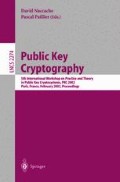Abstract
In the trivial n-recipient public-key encryption scheme, a ciphertext is a concatenation of independently encrypted messages for n recipients. In this paper, we say that an n-recipient scheme has a “shortened ciphertext” property if the length of the ciphertext is almost a half (or less) of the trivial scheme and the security is still almost the same as the underlying single-recipient scheme. We first present (multi-plaintext, multi-recipient) schemes with the “shortened ciphertext” property for ElGamal scheme and Cramer-Shoup scheme. We next show (single-plaintext, multi-recipient) hybrid encryption schemes with the “shortened ciphertext” property.
Chapter PDF
Similar content being viewed by others
References
O. Baudron, D. Pointcheval and J. Stern: “Extended Notions of Security for Multicast Public Key Cryptosystems”, ICALP’ 2000 (2000)
M. Bellare, A. Boldyreva and S. Micali: “Public-key encryption in a multi-recipient setting: Security proofs and improvements”, Advances in Cryptology-Eurocrypt’ 2000 Proceedings, Lecture Notes in Computer Science Vol.1807, Springer Verlag, pp.259–274 (2000)
M. Bellare and P. Rogaway: “Random oracles are practical: A paradigm for designing efficient protocols”, Proc. of the 1st CCS, pp.62–73, ACM Press, New York, 1993. (http://www-cse.ucsd.edu/users/mihir/crypto2k)
D. Boneh: “Simplified OAEP for the RSA and Rabin Functions”, Advances in Cryptology-Crypto’2001 Proceedings, Lecture Notes in Computer Science Vol.2139, Springer Verlag, pp.275–291 (2001)
D. Bonehand M. Franklin: “An efficient public key traitor tracing scheme”, Advances in Cryptology-Crypto’99 Proceedings, Lecture Notes in Computer Science Vol.1666, Springer Verlag, pp.338–353 (1999)
B. Chor, A. Fiat, and M. Naor, B. Pinkas: “Tracing traitors”, IEEE Trans. on IT, vol.46, no.3, pages 893–910 (2000).
D. Coppersmith: “Finding a small root of a univariate modular equation”, Advances in Cryptology-Eurocrypt’96 Proceedings, Lecture Notes in Computer Science Vol.1070, Springer Verlag, pp.155–165 (1996)
D. Coppersmith: “Small solutions to polynomial equations, and low exponent RSA vulnerabilities”, Journal of Cryptology, 10, pp.233–260 (1997)
R. Cramer and V. Shoup: “A practical public key cryptosystem provably secure against adaptive chosen ciphertext attack”, Advances in Cryptology-Crypto’98 Proceedings, Lecture Notes in Computer Science Vol.1462, Springer Verlag, pp.13–25 (1998)
S. Goldwasser and S. Micali: “Probabilistic encryption”, Journal Computer and System Sciences, vol.28, pp.270–299 (1984).
J. Hastad: “Solving simultaneous modular equations of low degree”, SIAM Journal of Computing, vol.17, pp.336–341 (1988).
K. Kurosawa and Y. Desmedt: Optimum traitor tracing and asymmetric schemes witharbiter. Advances in Cryptology — Eurocrypt’98, Lecture Notes in Computer Science #1403, Springer Verlag (1999) 145–157
K. Kurosawa and T. Yoshida: “Linear code implies public-key traitor tracing”, PKC’02 (this proceedings)
M. Naor and O. Reingold: “Number theoretic constructions of efficient pseudorandom functions”, FOCS’97, pp.458–467 (1997).
M. Stadler: “Publicly verifiable secret sharing”, Advances in Cryptology-Eurocrypt’96 Proceedings, Lecture Notes in Computer Science Vol.1070, Springer Verlag, pp.190–199 (1996)
Y. Zheng and J. Seberry: “Practical approaches to attaining security against adaptively chosen ciphertext attacks”, Advances in Cryptology-Crypto’92 Proceedings, Lecture Notes in Computer Science Vol.740, Springer Verlag, pp.292–304 (1992)
Author information
Authors and Affiliations
Editor information
Editors and Affiliations
Rights and permissions
Copyright information
© 2002 Springer-Verlag Berlin Heidelberg
About this paper
Cite this paper
Kurosawa, K. (2002). Multi-recipient Public-Key Encryption with Shortened Ciphertext. In: Naccache, D., Paillier, P. (eds) Public Key Cryptography. PKC 2002. Lecture Notes in Computer Science, vol 2274. Springer, Berlin, Heidelberg. https://doi.org/10.1007/3-540-45664-3_4
Download citation
DOI: https://doi.org/10.1007/3-540-45664-3_4
Published:
Publisher Name: Springer, Berlin, Heidelberg
Print ISBN: 978-3-540-43168-8
Online ISBN: 978-3-540-45664-3
eBook Packages: Springer Book Archive




